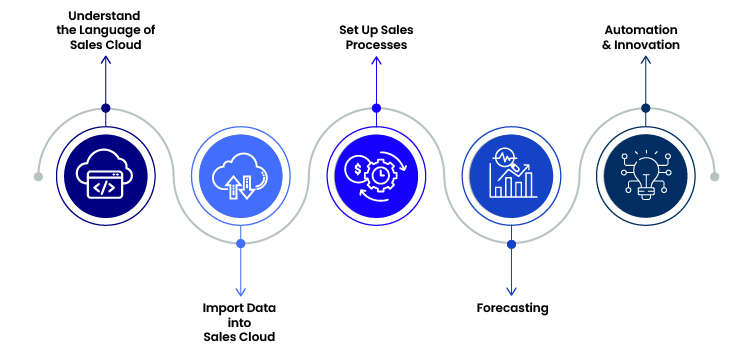

Chintal Shah
6 Minutes read
Maximizing Returns on Your Salesforce Sales Cloud Investment in 5 Steps
Salesforce Sales Cloud is a Customer Relationship Management (CRM) platform designed to boost the efficiency of an organization’s sales team and drive sales revenue. This customizable product aims to consolidate all customer information into a single integrated platform. It provides access to both customer account information and data collected from social media platforms, enabling sales teams to better assess leads and close deals more quickly. By providing intelligent insights and maximizing touch points across every channel, Sales Cloud can expedite deals and help businesses generate revenue more rapidly. To fully leverage the potential of the Sales Cloud platform, businesses can enlist the services of Salesforce Sales Cloud Consultants. These consultants are valuable partners, enabling businesses to enhance sales, streamline operations, and achieve their objectives.
Salesforce provides five versions of Sales Cloud
- Group
- Professional
- Enterprise
- Unlimited
- Performance
The main business goals of Sales Cloud are as follows:
- Access to more deals: Continuous optimization of campaigns based on market response and improved interaction with channel partners to secure more deals.
- Closure of more deals: Driving more leads to closure by providing access to account and product information tailored to customer needs.
- Faster closure of deals: Utilizing visual workflow design and mobile apps for quicker approval of business processes to expedite deal closures.
- Faster decision-making: Accessing detailed business scenarios through dashboards and reports to enhance sales forecasting accuracy and facilitate faster business decision-making.
Important Steps for Salesforce Sales Cloud Implementation
Let’s grasp the significance of elements for the successful implementation of Salesforce Sales Cloud

Step 1 - Understand the Language of Sales Cloud
- Leads: These are organizations and individuals with whom you want to do business. They are the smallest data sets and are not yet connected to your Salesforce data.
- Opportunities: These are individuals or organizations that represent potential revenue sources after the initial pitch or interaction.
- Accounts: These are organizations and individuals with whom you have an ongoing business relationship. To enable Sales Cloud to manage your accounts effectively, it’s important to import recent invoices.
- Contacts: Contacts are individuals whose contact information you have and who are associated with each of the above categories. You will reach out to these people for your sales pitches, follow up on invoicing, and more.
Step 2 - Import Data into Sales Cloud
The next step in setting up Salesforce Sales Cloud is to import and load data into the software. You can import data from any program using a “.csv” file. For small businesses, you can use the Data Import Wizard, which can handle about 50,000 records at a time and easily detect duplicate records. This is helpful if you’re implementing Sales Cloud without the help of an IT team.
For larger firms, Data Loader is used to import up to 5 million records at a time and to export files. Data Loader is useful for sharing files across offices or branches.
Sales Cloud can also pull data from external sources such as social media profiles, allowing you to follow up with leads, pitches, and contacts with more insight. It’s important to follow the correct Salesforce Sales Cloud implementation guide and ensure that your records are accurate, or else you might end up using updates from the wrong social profile.
Step 3 - Set Up Sales Processes
Once you have imported your data, you must instruct the Sales Cloud on how to handle the data. You can align your current sales processes with the advanced features of Salesforce Sales Cloud. The Cloud provides all the necessary tools for a sales team to perform essential tasks. As Sales Cloud offers highly customizable tools for sales teams, it’s important to spend time refining your processes to uncover new revenue sources and improve productivity.
Step 4 - Forecasting
Feedback and success metrics are crucial parts of a business strategy. It’s important to familiarize yourself with the forecasting and performance dashboards and reports in the Sales Cloud. The forecasting features in Salesforce Sales Cloud help you predict product inventory and staffing resources more accurately, reducing overhead costs and increasing profits. By adjusting staffing levels to meet demand during busier periods, you can ensure that customer queries are promptly addressed. This improves the likelihood of repeat customers and leads to business growth.
Step 5 - Automation and Innovation
It’s critical for sales teams to have ample time to dedicate to their customers. That’s why the final step in the Salesforce Sales Cloud Implementation checklist is to establish automated tools to alleviate the workload for your team and enable them to focus on crucial tasks.
By integrating Sales Cloud with Marketing Cloud, you can revolutionize how you generate new leads and, consequently, new revenue streams. You’ll gain insights into which marketing campaigns have proven successful for your clients and can tailor your messaging to reach a wider audience.
When you integrate Sales Cloud with Service Cloud, you’ll gain seamless access to your customers’ purchase history, enabling you to address issues more efficiently with relevant information at hand. The quote-to-cash (QTC) feature of the Sales Cloud allows you to enhance your invoicing and forecasting by updating financial records automatically. This provides you with a comprehensive view of the sales process for your clients and allows you to tailor your efforts to their needs.
Another key feature is Einstein AI, which provides data-driven insights on various topics. For example, Einstein AI facilitates advanced lead prioritization using machine learning algorithms and suggests additional pathways for revenue targeting. AI technology also aids in analyzing your business performance, enabling you to enhance the accuracy of your forecasts.
Summing Up
Sales Cloud is a highly effective tool for businesses aiming to diversify revenue streams and strengthen their organization’s future. It provides valuable insight into the sales process, enabling precise targeting of new clients and opportunities. Implementing Sales Cloud with the help of Salesforce Sales Cloud consultants like ACL Digital equips your sales team with innovative tools to attract clients and boost revenue. For more information, get in touch with experts at business@acldigital.com.



